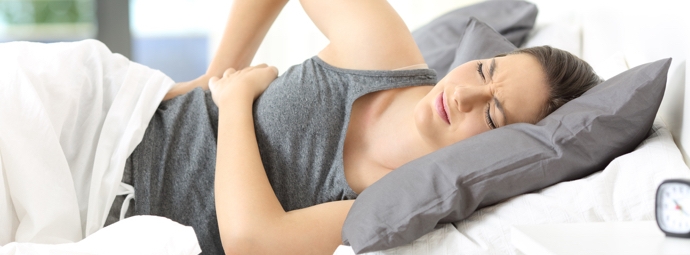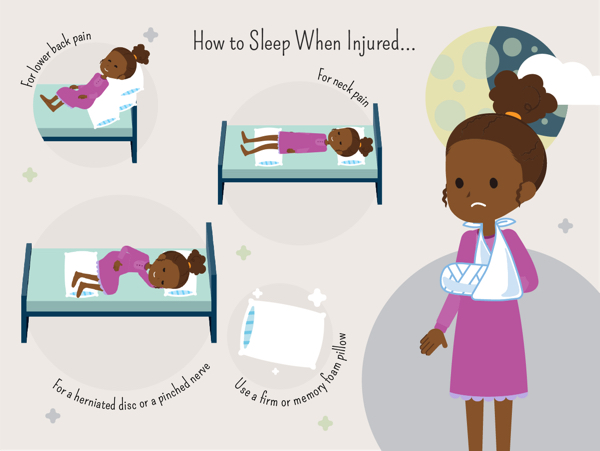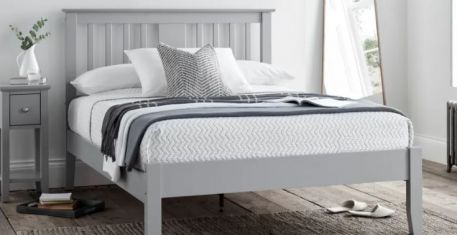
Most of us will probably have suffered some kind of injury in our lifetime. Some smaller than others, some more long term. Whatever the damage, learning to sleep with a hinderance can take time and patience.
Don’t worry if you find yourself tossing and turning for the first few nights, this is to be expected. It’s important to understand the injury and its healing process and try to find the best sleeping position for you.
Why sleep is important (especially when injured)
According to the Sleep Council, people are now focussing more on sleep, and understanding how a combination of factors such as bedtime routine, exercise and relaxation play a part in creating a happy lifestyle.
The body’s healing process is different for everyone and is influenced by a number of different factors. However, sleep can be a powerful healing tool as it gives the body a chance to recover. Netdoctor suggests that when we’re sleeping, our brains give out certain hormones that help our bodies to repair. As well as this, the site explains how we also produce more immune white blood cells while we rest.
The amount of sleep we get each night can also work some way in speeding up our recovery process. Having less than seven hours can leave us more prone to colds and illnesses, whereas eight hours of sleep could just help your body to recover quicker.
How to sleep with back pain
Back pain is a particularly common ailment. While NHS advice is to stay active for as long as possible because long periods of rest can make the pain worse, when it comes to sleeping, unfortunately staying still can’t be avoided.
Poor bed posture can enhance back pain, so it’s really important to speak to your doctor about the best position for your injury. Usually, it’s helpful to align the head, shoulders and hips and adopt the ‘sleeping on the back’ position.
Best sleeping positions for back pain
While sleeping on your back might be the recommended position, it’s not always the most comfortable. Thankfully there are a variety of positions to try which may help you nod off into a restful slumber.
Sleeping with a herniated disc
According to Medical News Today, people with a herniated disc might find the foetal position the most comfortable, because lying on your side with your knees tucked in close can help to prevent your spine from bending. This position is also said to help open up your joints.
Sleeping with extra pillows, particularly memory foam, can create added comfort and help you to get a good’s night sleep despite the injury.

Sleeping with lower back pain
For anyone suffering with lower back pain, sleeping in a reclined position may help. An adjustable bed may be a good investment if you find this comfortable, as it can help you lay with additional support and alignment.
Sleeping with a pinched nerve
Try lying on your back with your legs to one side and pop a pillow between your knees. Extra supportive pillows will work better and are definitely worth considering. Other positions include lying on your side in the foetal position or lying on your stomach with a pillow underneath your abdomen.
How to sleep with neck pain
Neck pain can occur from a variety of different situations; from sitting and staring at a computer screen for too long to playing sport and pulling a muscle. It can even be the outcome of poor posture while in bed and sleeping for hours on end in this position.
If you’re experiencing a neck injury the first thing to do is to consult your doctor about the best way to deal with the pain and kickstart the healing process.
How you sleep will probably be a big part of this. According to the NHS, using a low, firm pillow is an essential way to ease neck pain. Depending on the injury, sleeping with either a heated or cold pack is also a good idea, while also doing some neck exercises before bed to relieve the tension.
Other useful tips to help aid your sleep include sleeping on your back or side for proper spinal alignment, raising your legs ever so slightly and putting a roll (or pillow) under your knees. You might find it beneficial to try cervical support aids too, this will help with posture and provide support where needed.
Choosing the correct pillow will be a vital consideration when suffering with a bad neck – you might find pillows with additional features such as an elite gel memory foam pillow helpful, as they’re formulated to be soft and supportive, as well as durable and consistent.
How to sleep with a bad leg
Leg injuries can come in all shapes and forms. For example, the NHS categorises hamstring injuries into grade 1 (a mild muscle pull or strain), grade 2 (a partial muscle tear) and grade 3 (a complete muscle tear). The length of time it takes to recover depends on the severity of the injury.
Sleep forms an instrumental part of any recovery process. It’s something we all need, and even more so when we obtain an injury. The position of your leg when sleeping with this type of injury can quicken the healing process, or, in some cases, make it worse. When you’re sleeping, tingling sensations, cramps or spasms can be reduced if you ensure your injured leg is elevated.
A crooked or bent leg can cause additional stress to the muscle or joint, and ultimately cause unnecessary pain and discomfort.
A good night’s sleep is something we all strive towards, yet when experiencing an injury of some sort, it can be particularly difficult and frustrating, to say the least.
Try not to panic, take some deep breaths and do your research beforehand. Even when injured, it’s possible to get those recommended eight hours kip!
Take a look at our guides on getting the best possible sleep, whether you’ve got an injury, are ill, or are simply interested to know just how much of it you need!



